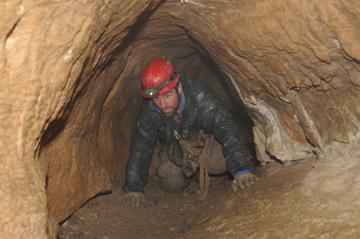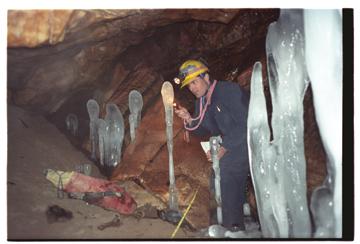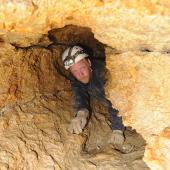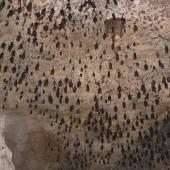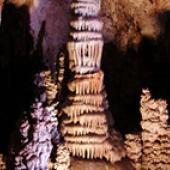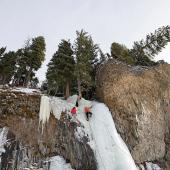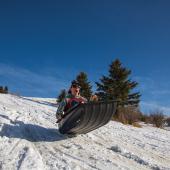Going Deep
"Listen!" says Peter, who is lying on his side a few feet in front of me in the small canyon-shaped passage. "I think I hear thunder."
I can only see the muddy soles of his boots by the light of my headlamp, and I didn't hear anything unusual. All I hear are muffled scraping and exhalations from Mike, who is some distance ahead of us along this strenuous constricting crawl. I'm not too worried about thunder and lightning, because we're far from the entrance, but I am starting to get cold. For the past couple hours, we've shimmied, squirmed, and belly-crawled through dank, dark passages, some not much bigger than us. A few had water running right down the center, which added to the discomfort and danger of our underground excursion.
Hypothermia is a real concern in this cold and wet limestone cave. At this point we aren't crawling along just for fun; it's the only way back to the earth's surface. I scrape the specks of mud off my headlamp and keep following Peter toward the exit, toward the warmth and security of terra superus far above.
Subterranean 101
Exploring caves is an activity with many levels of difficulty, and Montana has caves to satisfy anyone. Lewis and Clark Caverns, above the Jefferson River, is Montana's only tourist cave—all the rest are "wild" caves where visitors bring their own lights and are responsible for finding their way in and out. Montana has several hundred caves, and more are discovered every year in the vast areas of limestone exposed in the western mountains. Some are deep and dangerous, requiring expert skills to visit, and others are relatively easy to traverse.
Limestone caves are thought to form near the top of the water table, where acidic groundwater etches cavities into limestone rock, which dissolves relatively easily. Cracks, faults, and layers control the growth of these cavities, which can range from small, inch-wide fissures to huge rooms larger than football stadiums. Rainwater percolating through the rock carries minerals with it, and these can become the familiar stalactites, stalagmites, and other flowstones found in caves. Mineral-rich water seeping through the walls of a cave can also leave a crystal lining, like the inside of a geode, or form bizarre antlerlike formations known as helictites. These formations are all fragile and cavers have to take great care not to damage them as they pass by.
When the water table is later lowered by the down-cutting of nearby rivers or the uplift of mountains, surface erosion may expose a cave entrance. But caves may contain streams, pools, sticky mud, and deep pits along with difficult climbing and crawling. So exploring them requires durable clothing, and gear that would last for years on the surface can be destroyed in a few hours of caving. Cavers often wear nylon coveralls, knee pads, and gloves, and most carry a small, durable pack. Essential gear includes a helmet with a headlamp, extra lights, and batteries. Caves with deep pits require ropes and other gear for descending and ascending. Caves with streams or deep pools might require wetsuits and diving equipment.
If an accident occurs in a cave, a rescue can be extremely difficult. No helicopter can help you, and few responders are trained in cave rescue. The best bet is to avoid accidents by being aware of the changing hazards around you and adhering to these rules: never cave alone, always bring at least three sources of light, and always tell someone where you've gone and when you'll return.
Famous Caves
Montana's longest cave is Bighorn Caverns, in the northern Bighorn range, with over 14 miles of passage. Montana's deepest cave is Virgil the Turtle's Greathouse Cave in the Bob Marshall Wilderness Area at minus 1,586 feet. In comparison, the longest cave in the world is the Kentucky's Mammoth cave system, with 360 miles of mapped passage. The deepest known cave in the world is Voronja cave in Abkhazia, Republic of Georgia, at minus 5,610 feet.
Miles City native and former Bozeman resident Jason Ballensky discovered Virgil the Turtle's Greathouse Cave, which proved to be the second-deepest cave in the continental United States, in 2005. "Four of us completely mapped and explored Virgil the Turtle's Greathouse Cave after three different trips," says Jason. "Each trip into the cave lasted roughly eight hours. Most of the passage in the cave is very big and it was easy to move quickly. The only serious obstacles we faced inside the cave were two small pits that we needed rope to rappel to the bottom of. Getting to the cave is actually the biggest obstacle and consumed much more time than exploring it. [The cave is 25 miles from the nearest trailhead.] Our backpacks were extremely heavy because we were carrying all our caving gear in addition to the normal gear that you would bring on a 10-day trip into the mountains."
Jason returns each summer to search for caves in the wilds of Montana. Is he just a little crazy, hiking dozens of miles through rugged alpine country to descend cold, dark, subterranean cavities? Perhaps, but so are we. Covered in mud and shivering—it can't be more than 38 degrees in this cave—we slowly make our way back to the surface. Route-finding is challenging but manageable, and eventually we see a speck of light far ahead. A thunderstorm rumbles overhead as we scramble out of the cave, and rain splatters the rocks surrounding the cave entrance. Still, we're happy to be above ground. Even with the rain, it's downright toasty compared to where we've just been. Trading our cold, muddy coveralls for dry hiking shorts, we're all smiles as we head back down the trail toward the car and eventually, Livingston, where burgers and cold beer await.
Cavers Versus Spelunkers: Don't go there
James Cummins
Here's a lesson in caving etiquette: Cavers don't like to be called spelunkers. Although it's common to hear people call us spelunkers, and even though spelunker is much more fun to say than caver, we want you to knock it off.
The word spelunking is old. We know. Etymonline.com says the word has French, Latin, and Greek origins that are centuries old, and it defines a spelunker as "a cave bug; one who explores caves as a hobby." But just as the word thong is worn no longer on the foot but a little farther north, meanings change.
The National Speleological Society cave dictionary defines a spelunker as "a person who goes into caves without proper equipment or the desire to learn/practice proper safety/conservation techniques." So for example: When five people go spelunking, everyone has well-worn tennis shoes, two might have flashlights, one may claim to know about the cave, and none in the group has a helmet.
In other words, spelunker has come to denote a clueless beginner. It's one reason behind the common yarn that spelunker actually comes from the sound one makes when he slips, falls, and lands in a pool of water—SPEE-LUNK!
Caving Resources/Guides
People interested in visiting a cave should try a show cave like Lewis and Clark Caverns, near Cardwell, first to see if the lure of darkness is truly upon them. This cave is heavily decorated and is worth a visit. Seeing a wild cave is more involved, and it's best to go with someone who knows the way and can show you how to cave safely.
For more information on caves, visit the website of the National Speleological Society, (caves.org) which is an organization devoted to the exploration and conservation of caves.
Caves of Montana, by geologist Newell Campbell, is one of the oldest and one of the best books about Montana's caves. Order it from the Montana Bureau of Mines and Geology online catalog at mbmg.mtech.edu.
Another useful book is Alpine Caving Techniques, by Georges Marbach and Bernard Tourte.


